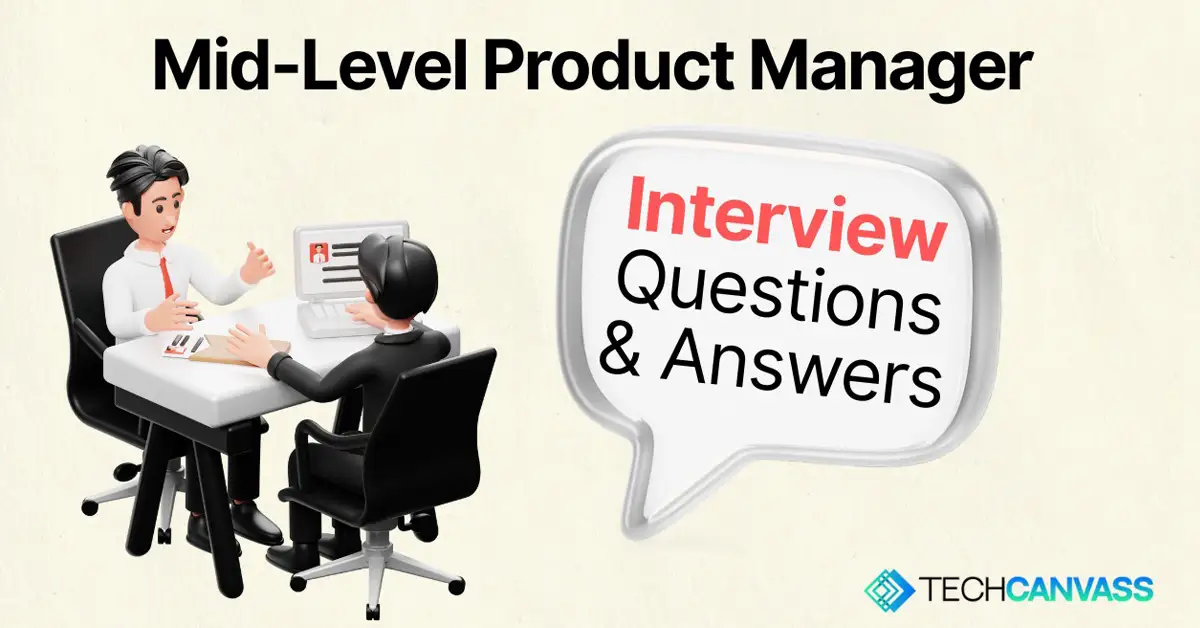Last Updated on October 31, 2025 by Techcanvass Academy
Table of Contents
Overview
Mid-level Product Managers are expected to combine strategic vision with hands-on execution. Interviewers look for structured thinking, data-driven decision-making, and leadership in cross-functional collaboration. In this guide, we cover 30 of the most common Product Manager interview questions and answers, each supported with contextual examples to help you prepare with confidence.
Useful Links
Product Manager Interview Questions And Answers with Examples
1. How do you define a successful product?
A successful product delivers customer value while meeting business objectives.
2. Explain your approach to building a product roadmap.
I start by linking the roadmap to the company’s strategic goals, then define themes, prioritize using RICE, and communicate milestones to stakeholders.
3. How do you prioritize features when resources are limited?
I use data-backed frameworks like RICE or Value vs. Effort to focus on features delivering maximum impact.
4. What frameworks do you use for product prioritization?
I use RICE for data-driven prioritization, MoSCoW for sprints, and Kano for customer delight mapping.
5. How do you define product vision?
It’s a North Star guiding all decisions, aligning teams around long-term outcomes.
6. How do you validate a new product idea?
Validate in phases
Research
User interviews, analytics review, jobs-to-be-done.
Prototype
Sketch ideas, wireframes, interactive prototypes.
Market Testing
A/B tests, pilots, landing pages, user feedback.
Iteration
Refine based on adoption & real-world data.
Useful Links
7. What metrics do you track for product success?
Key metrics vary: engagement, retention, churn, NPS, conversion.
8. Describe your experience with user research.
I mix qualitative and quantitative data to uncover insights.
9. How do you handle conflicting stakeholder priorities?
I align decisions using data and business outcomes.
10. Difference between a product manager and a project manager?
Product Managers focus on solving the right problem; Project Managers ensure timely execution.
11. How do you measure customer satisfaction?
Using NPS, CSAT, and retention data.
12. When do you sunset a product?
When it no longer delivers value or drains resources.
Useful Links
13. Share a failure and what you learned.
14. How do you perform market analysis?
By studying competitors, trends, and target segments through tools like SimilarWeb, Crunchbase, and surveys.
15. Describe your go-to-market (GTM) strategy.
Target the right audience, define value props, and align marketing and sales.
16. How do you use data in decisions?
Combine analytical metrics (quantitative) with feedback (qualitative).
17. How do you balance short-term delivery with long-term vision?
By maintaining dual tracks: tactical (monthly sprints) and strategic (quarterly OKRs).
18. What’s your MVP strategy?
Build the smallest version that validates assumptions.
Useful Links
19. How do you collaborate with engineering?
Through transparent goals, regular stand-ups, and joint retrospectives.
20. . How do you influence without authority?
Empathy + Data + Clear Vision.
21. How do you approach product discovery?
Combining market gaps, analytics, and user interviews.
22. What is North Star Metric?
A single success indicator showing ongoing user value delivery.
23. How do you decide which problems to solve first?
I score based on impact, urgency, and feasibility.
24. What role does UX play in product success?
Critical for engagement and retention.
Useful Links
25. How do you set OKRs?
Align them with company goals, make results measurable, and review quarterly.
26. How do you refine a backlog?
Review regularly, clarify acceptance criteria, and reprioritize.
27. How do you ensure alignment across teams?
Through open communication and shared dashboards.
28. How do you control feature creep?
Set clear scope and validate requests before approval.
29. How do you define your target audience?
Use user segmentation via demographics, psychographics, and behaviour data.
30. What product management trends do you follow?
AI-driven insights, Product-Led Growth (PLG), no-code prototyping, and ethical UX.
Useful Links
Conclusion
Mid-level Product Managers succeed by blending business acumen, customer obsession, and collaboration. When answering Product Manager interview question and answers, structure your response as:
Back every answer with numbers, learnings, or user outcomes to demonstrate real-world thinking.



